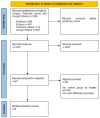Turner Syndrome and the Thyroid Function-A Systematic and Critical Review
- PMID: 39684648
- PMCID: PMC11641386
- DOI: 10.3390/ijms252312937
Turner Syndrome and the Thyroid Function-A Systematic and Critical Review
Abstract
Turner syndrome (TS) is associated with thyroid disorders. Since the rate of thyroid disease among patients with this syndrome is significantly higher as compared to the general population, it seems vital to explore this particular area. This systematic and critical review was performed to evaluate thyroid function and autoimmunity in patients with Turner syndrome. Four databases were searched: PubMed, Scopus, Google Scholar, and Cochrane Library from the onset of the study to July 2024. Two independent researchers manually searched databases for the following keywords: "Turner syndrome", "anti-TPO", "anti-Tg", "autoimmune thyroid disorders", "TSH", and "hypothyroidism", which were entered into the search engine in isolation, as well as in combinations. Criteria incorporating information on thyroid-stimulating hormone (TSH), triiodothyronine (total-TT3), and thyroxine (free and total-fT4, TT4) concentrations among patients and control groups were also included. Thyroid diseases are common in patients with Turner syndrome. Women with TS present both higher TSH levels and positive thyroid antibodies concentrations. Typical thyroid ultrasound heterogeneity with a hypogenic or mixed echopattern was also observed. As a result, it is essential to monitor thyroid hormone levels in this group, in order to detect hypothyroidism earlier and initiate appropriate replacement therapy. Thyroid diseases in women with TS may remain underdiagnosed for a number of years, due to the lack of screening. Therefore, the authors suggest a thyroid screening regimen for TS patients, which allows for early detection of the disease and implementation of treatment.
Keywords: Turner syndrome; anti-thyroid antibodies; autoimmunity; hypothyroidism; thyroid function; thyroid hormones.
Conflict of interest statement
The authors declare no conflicts of interest.
Figures




References
-
- Gravholt C.H., Andersen N.H., Conway G.S., Dekkers O.M., Geffner M.E., Klein K.O., Lin A.E., Mauras N., Quigley C.A., Rubin K., et al. Clinical practice guidelines for the care of girls and women with Turner syndrome: Proceedings from the 2016 Cincinnati International Turner Syndrome Meeting. Clin. Endocrinol. 2017;55:223–226. doi: 10.1530/EJE-17-0430. - DOI - PubMed
-
- Czyzyk A., Lacka K., Krawczynski M., Andrzejewska J., Wojda A., Skolozdrzy J., Latos-Bielanska A. Analysis of phenotype and karyotype of children born from mothers with 45, X/46, XX mosaicism. Endocrinologist. 2010;20:283–285. doi: 10.1097/TEN.0b013e3181fcfeba. - DOI
Publication types
MeSH terms
Substances
LinkOut - more resources
Full Text Sources
Medical
Research Materials
Miscellaneous

